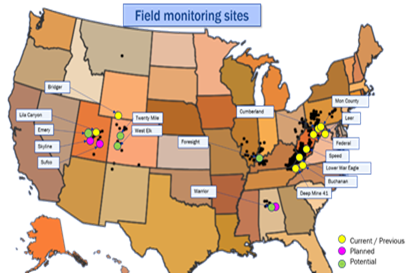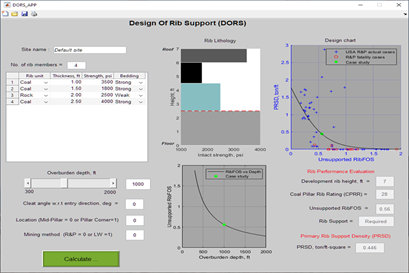Mining Project: Integrated Analysis of Coal Pillar and Entry Stability
| Principal Investigator |
|
|---|---|
| Start Date | 10/1/2019 |
| Objective |
In recent years, ground falls have accounted for approximately 25% of the fatalities in underground coal mines. Current stability analysis techniques consider pillar, roof, and rib stability separately, although it is known that they are interrelated. Therefore, this project takes a holistic approach to coal mine stability analysis by developing an integrated analysis procedure for coal pillar and entry stability. A successful integration of pillar and entry stability analysis will significantly impact the safety of the nation’s underground mine workers. |
| Topic Areas |
Research Summary
Approach
The research strategy for this project involves the supplementation of currently available ground stability data with additional in-mine data collection, with an emphasis on geographical regions that were underrepresented in previous NIOSH research. Numerical models are then calibrated from the collected field data and used to conduct parametric studies. Collaborative stakeholders include the Leer, Cumberland, Mon County, Federal #2, Lower War Eagle, Buchanan, Warrior #4, Bridger, Lila Canyon, Century, ICG Beckley, and Maple Eagle mines as well as the Spokane Mining Research Division (SMRD), West Virginia University, and The Missouri University of Science and Technology.
Milestones and Accomplishments
| Description | Audience | Year |
|---|---|---|
| Developed enhanced Rib Factor Of Safety (RibFOS) to analyze solid coal ribs and ribs with rock parting. | Researchers, consultants, mine engineers, mine operators | 2021 |
| Collected and published data from over a dozen coal mines in support of all tasks. | Researchers, consultants, mine engineers, mine operators | 2022 |
| Enhanced numerical modeling of mine-induced seismicity in support of the pillar stability task. | Researchers, consultants, mine engineers, mine operators | 2022 |
| Calibrated Bonded Block Models (BBMs) against field measurements to quantify interaction of roof supports. | Researchers, consultants, mine engineers, mine operators | 2023 |
| Calibrated Boundary Element Models (BEMs) to quantify the impact of in-seam partings on pillar stability. | Researchers, consultants, mine engineers, mine operators | 2023 |
| Collaborating with mine operators to beta test the Design of Rib Support (DORS) software. | Mine engineers, mine operators | 2023 |
Planned Impacts and Outcomes
The planned outcomes for this project include (1) development of a rockmass classification tool to determine material and bedding strength, and (2) that mine operators will adopt the procedures for the integrated analysis of coal pillar and entry stability. Measures for the success of these outcomes involve determining how many mine operators adopt this analysis technique. This can be determined from web traffic and product downloads, mine site visits, interactions with stakeholders, and literature citations.
Data collected from this project research will serve underrepresented populations while simultaneously providing for the widest possible breadth of field conditions encountered in U.S. mines. This data will then be used in a hybrid empirical/numerical modeling approach. Validated models will serve as the basis for large-scale parametric studies, resulting in a large database of hypothetical case histories much larger than what could be obtained through instrumentation and observation alone. Numerical modeling standalone software will also be developed that does not require the end user to possess the training or the time required to learn and implement complex numerical models themselves, allowing mine engineers and management to make sound, engineering-based decisions for the design of mine excavations. This will result in a significant impact on the health and safety of mine workers.
Outputs
Klemetti TM, Van Dyke MA, Esterhuizen GS [2020]. Bleeder entry evaluation using condition mapping and numerical modeling. In: Proceedings of the 39th International Conference on Ground Control in Mining (ICGCM), Canonsburg, PA, July 28-30, pp. 105-115.
Van Dyke MA, Klemetti TM, Compton C [2020]. Coal mine entry rating system: A case study. In: Proceedings of the 39th International Conference on Ground Control in Mining (ICGCM), Canonsburg, PA, July 28-30, pp. 257-266.
Esterhuizen GS, Klemetti T, Sears MM, Zhang PR, Van Dyke M, Dougherty H, and Tulu IB [2021]. Assessing longwall gateroad ground response and support alternatives. Min Metal Expl 38(1):1739-1759.1007/s42461-021-00430-x.
Mohamed K, Kimutis R [2021]. DORS standalone application—design of rib support. Presented at SME/PCMIA Annual joint meeting.
Khademian Z, Sears MM, Van Dyke MA, Su WH [2022]. Evaluating seismic potential by energy balance calculations in a deep longwall mine. In: Proceedings of RaSiM 10 Rockbursts & Seismicity in Mines. April 26-27. Tuscan, AZ: Society for Mining, Metallurgy & Exploration.
Van Dyke M, Klemetti TM, Wickline J, Beale J [2022]. Forecasting seismic potential in a longwall coal mine. In: Proceedings of RaSiM 10 Rockbursts & Seismicity in Mines. April 26-27. Tuscan, AZ: Society for Mining, Metallurgy & Exploration.
Zhang P, Sears M, Klemetti T, Van Dyke M, Wade S, McGrady A [2022]. Risk management to prevent coal outbursts in room-and-pillar mining under deep cover. RaSiM10: Rockburst and Seismicity in Mines Symposium, April 26-28, 2022, Tucson, AZ.
Zhang P, Esterhuizen G, Sears M, Trackemas J, Minoski T, Tulu B [2022]. Roof stability and support strategies associated with longwall-induced horizontal stress changes in belt entries. Mining, Metallurgy and Exploration 39(5):1873-1885.
Sears MM [2023] Field instrumentation and analysis of pillar performance at the Maple Eagle Mine. Presented at: SME/CAS Spring Meeting. Julian, WV. April 14
McElhinney M, Compton C, Mazzella M, Minoski T, Sears M, Morris M, Bright J [in press]. Field instrumentation and data analysis of ground movement and pillar performance at the Maple Eagle Mine in Southern West Virginia. In: Proceedings of the 42nd International Conference on Ground Control in Mining (ICGCM). Cannonsburg, PA July 25-27.
Supporting Visuals

Map representing the use of data collected for this project from across the United States. This includes all major bituminous coal-producing regions including the Northern, Central, and Southern Appalachian basins, the Illinois Basin, and the Western coal fields.

Representation of parametric study results, analyzed using regression techniques or machine learning algorithms to develop a prediction of the numerical modeling results from standardized input parameters.